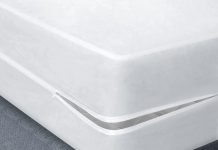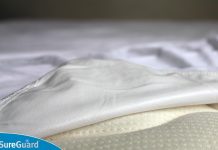We all know the importance of a good night’s sleep, and one key element in achieving that is a quality mattress protector. But how do we know when it’s time to replace our trusty mattress protector? In this article, we’ll explore the signs that indicate it’s time to bid farewell to our old mattress protector and find a new one. From wear and tear to pesky stains, we’ll uncover the telltale signs that will help us sleep soundly once again.
Review contents
Stains and Spills
Visible stains and spills
One of the clear signs that it may be time to replace your mattress protector is the presence of visible stains and spills. Over time, accidents happen, whether it’s a spilled drink or a late-night snack mishap. Even with the best intentions to clean up spills promptly, some stains can become ingrained in the fabric, making them difficult or impossible to remove completely.
Failure to remove stains
If you find that your mattress protector is failing to protect your mattress from stains, it might be time for a replacement. While mattress protectors are designed to create a barrier against spills and accidents, some protectors simply do not live up to their promises. If you notice that your mattress is becoming stained despite the use of a protector, it’s a clear indication that it’s time to find a more reliable option.
Odor and mold growth
Another issue that can arise over time is the development of odors or mold growth on your mattress protector. Moisture from sweat or spills can create the perfect environment for mold and mildew to grow, leading to unpleasant smells and potential health hazards. If you notice any musty odors or discoloration on your mattress protector, it’s essential to replace it promptly to prevent further damage to your mattress and potential respiratory issues.
Torn or Damaged
Visible tears or holes
A sure sign that your mattress protector needs replacing is the presence of visible tears or holes. Over time, the constant stretching, tugging, and movement in bed can cause the fabric of your protector to weaken and eventually tear. Once tears or holes start appearing, the protective barrier is compromised, leaving your mattress vulnerable to stains, spills, and even bed bugs. It’s time to invest in a new mattress protector to ensure the continued longevity of your mattress.
Loss of waterproofing
If you find that your mattress protector is no longer waterproof, it’s definitely time for a replacement. The primary purpose of a mattress protector is to shield your mattress from liquid damage, including spills, accidents, and even pet dander. If you notice that liquid is seeping through your protector, leaving your mattress vulnerable, it’s crucial to find a new protector that effectively maintains its waterproofing capabilities.
Loose straps or elastic
An often-overlooked sign that your mattress protector needs replacing is the presence of loose or worn-out straps or elastic. Properly fitted straps and elastic are crucial for keeping your protector securely in place, ensuring it doesn’t shift or bunch up during the night. If you find that your protector is starting to slip or the straps no longer provide a snug fit, it’s time to consider a replacement to maintain optimal protection and comfort.
Allergies and Irritation
Increased allergy symptoms
If you find that your allergy symptoms have increased, such as congestion, sneezing, or watery eyes, it may be a sign that your mattress protector is contributing to the problem. Over time, dust mites, pet dander, and allergens can accumulate in your protector, causing allergic reactions and exacerbating respiratory issues. Replacing your mattress protector with a hypoallergenic option can help alleviate these symptoms and provide a healthier night’s sleep.
Skin irritation or itching
Another sign that your mattress protector may need replacing is the presence of skin irritation or itching. Some protectors may be made from materials that are not hypoallergenic or skin-friendly, leading to discomfort and restless nights. If you notice any redness, itching, or rashes after using your current protector, it’s essential to switch to a more suitable option to ensure your skin’s health and overall well-being.
Uneven Padding
Lumps or sagging areas
If you start to notice lumps or sagging areas on your mattress, it may be a result of an uneven mattress protector. Over time, the constant pressure and movement can cause the filling or padding of your protector to shift or clump together, leading to an uncomfortable sleep surface. If you find that your mattress is losing its smooth and even feel, it’s time to replace your protector to restore optimal comfort and support.
Decreased comfort and support
A worn-out or inadequate mattress protector can also contribute to a decrease in overall comfort and support. As your protector ages, its ability to provide the necessary cushioning and pressure relief may diminish, leaving you tossing and turning throughout the night. If you find that your mattress is no longer providing the level of comfort and support you need, it’s worth considering a new protector to enhance your sleep experience.
Squeaking or creaking noises
Another telltale sign that your mattress protector needs replacing is the occurrence of squeaking or creaking noises. Over time, the normal wear and tear on your protector can result in the development of noise-producing gaps or friction points. If you’re regularly disturbed by annoying sounds emanating from your mattress, it’s a clear indication that your protector is nearing the end of its lifespan and that it’s time for an upgrade.
Bed Bug Infestation
Visible signs of bed bugs
Discovering visible signs of bed bugs on your mattress protector is a definite red flag that it’s time for a replacement. Bed bugs are notoriously difficult to eradicate once they infest your bedding, and a compromised protector can make them even harder to keep at bay. If you notice any small blood spots, dark spots, or even the bugs themselves, it’s crucial to act immediately and replace your protector to prevent a widespread infestation.
Failure to prevent bed bugs
If you’ve diligently used a mattress protector to protect against bed bugs but still find yourself dealing with an infestation, it’s time to reassess your current protector’s effectiveness. Inferior quality protectors may have gaps or weaknesses that allow bed bugs to infiltrate your mattress, rendering the protector essentially useless. Investing in a high-quality, bed bug-resistant protector can provide you with the peace of mind you need and effectively prevent future infestations.
Prolonged exposure to infested areas
In cases where you’ve recently moved from an infested environment or had prolonged exposure to bed bug-infested areas, including hotels or shared spaces, it’s essential to replace your mattress protector as a preventative measure. While your current protector may not show visible signs of bed bugs, eggs or nymphs could still be present and may hatch over time. By investing in a new protector, you can avoid the risk of carrying bed bugs into your home and protect your sleep environment.
Expiration Date
Check manufacturer’s recommendations
When it comes to the expiration date of your mattress protector, it’s important to check the manufacturer’s recommendations. Each protector may have different specifications based on its material composition, technology, and intended lifespan. By following the guidelines provided by the manufacturer, you can ensure that your protector remains effective for as long as possible and replace it when it reaches its expiration date.
Follow warranty guidelines
Additionally, it’s crucial to familiarize yourself with the warranty guidelines attached to your mattress protector. Some protectors come with warranties that offer protection against defects or premature wear and tear. If you find that your protector is showing signs of deterioration within the warranty period, be sure to follow the designated steps outlined by the manufacturer to potentially receive a replacement or refund.
Changes in Sleep Quality
Restlessness and discomfort
If you’re experiencing increased restlessness and discomfort during sleep, it could be a sign that your current mattress protector is no longer providing the necessary support and comfort. Over time, protectors can lose their ability to cushion pressure points and adequately distribute body weight, resulting in pain and discomfort. Upgrading to a new and more supportive protector can help improve your sleep quality and alleviate any discomfort you may be experiencing.
Difficulty falling asleep or staying asleep
Another indication that your mattress protector may need replacing is experiencing difficulty falling asleep or staying asleep through the night. If you find yourself tossing and turning, constantly adjusting your position, or waking up frequently, it may be a result of an uncomfortable or ill-fitting protector. By investing in a new protector that offers superior comfort and promotes better sleep, you can enhance your overall sleep quality and wake up feeling refreshed.
Aging and General Wear
Time-based replacement
Just like any other product, mattress protectors have a natural lifespan dictated by their materials and construction. While some protectors may last several years, others may need replacing more frequently. It’s important to evaluate the overall age and condition of your protector to determine if it’s time for a replacement. If your protector is showing signs of significant wear and tear, including thinning fabric or compromised waterproofing, it’s likely time to invest in a new one.
Excessive wear and tear
If you’re noticing excessive wear and tear on your mattress protector, such as fraying edges, holes, or significant fabric deterioration, it’s essential to replace it as soon as possible. A protector in this condition can no longer provide the necessary level of protection, allowing spills, stains, and allergens to reach your mattress. By promptly replacing your worn-out protector, you’ll extend the lifespan of your mattress and maintain a clean and healthy sleep environment.
Discoloration or Fading
Loss of color or vibrancy
If you notice that your mattress protector is losing its color or vibrancy over time, it may be an indication that it’s time for a replacement. Exposure to sunlight, cleaning agents, and normal wear and tear can cause the fabric of your protector to fade or become discolored. While this may not affect its functionality, a faded or discolored protector can impact the overall aesthetic appeal of your bed. By upgrading to a new protector, you can bring back the vibrant and fresh look to your sleep space.
Fading due to sunlight exposure
Sunlight exposure can be particularly damaging to mattress protectors, leading to significant fading over time. If your protector is near a window or regularly exposed to direct sunlight, it’s important to take this into consideration when evaluating its condition. Faded protectors not only lose their visual appeal but may also have compromised protective capabilities. If you notice fading due to sunlight exposure, it’s time to consider switching to a protector with enhanced UV resistance to prolong its lifespan.
Prolonged Use and Frequency
Regularly rotating mattress
If you’re using your mattress protector for an extended period without regular rotation, it may be time to replace it. The constant use and weight distribution on your mattress can cause your protector to wear unevenly. By frequently rotating your mattress and repositioning your protector, you can ensure that the pressure is distributed more evenly, reducing the risk of premature wear and tear. However, if you’ve neglected this practice and your protector is showing signs of significant wear, it’s advisable to replace it for optimal protection.
Frequent washing and drying
While it’s essential to maintain a clean and hygienic sleep environment, excessive washing and drying of your mattress protector can contribute to its wear and tear. Frequent exposure to high heat and agitation during the washing and drying process can weaken the fabric and decrease its protective qualities over time. If you find that your protector is becoming thin or losing its waterproofing capabilities due to frequent washing, it’s time to invest in a replacement to ensure continued protection and comfort.
In conclusion, knowing the signs that it’s time to replace your mattress protector can help you maintain a clean, comfortable, and healthy sleep environment. By paying attention to visible stains and spills, tears or holes, allergies and irritation, uneven padding, bed bug infestation, expiration dates, changes in sleep quality, aging and general wear, discoloration or fading, and prolonged use and frequency, you can ensure that your mattress remains protected and your sleep quality is optimized. Remember, investing in a high-quality mattress protector is an investment in the longevity of your mattress and your overall well-being.































